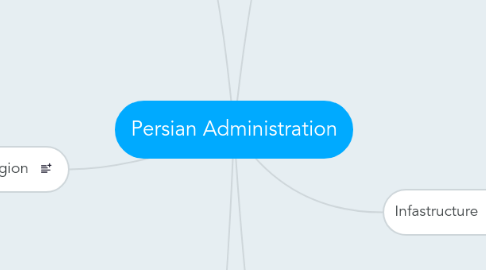
1. Government Structure
1.1. The government structure was a highly complex system that required multiple levels of bureaucrats to manage
1.1.1. The Persian empire was split into several designated sections called satrapies that made taxation much simpler. Each satrap was managed by an administrator also called a satrap. To manage the treat of rebellion the satraps were looked over by imperial spies and military officers who would continuously make checks on the satrap.
1.1.2. King Darius created a new form of standardized taxation that mixed excellently with the satrapies. Previously different regions would just provide a lavish gift to offer as tribute but those gifts could not keep an empire running so Darius made each satrap pay a specific amount of silver annually. This provided the money the empire needed to survive and made the process of taxation much easier.
2. Social Organization
2.1. The social structure of classical persia was just as complex as the rest of it's culture.
2.1.1. The hierarchical social structure was slightly different from other empire. The majority of people went under the designation of free classes which included everyone other than the clan leaders and bureaucrats This class is considered uniformly equal and each man has the same economic, social, and political rights. The bureaucrats played a crucial role in managing the empire and as such were given more slack when it came to the laws.
2.1.2. Slaves of the Persian empire were treated in a similar fashion to slaves of other major empires. Slaves were created from two sources, either prisoners of war or people who owed debts they could not pay. Slaves contributed much to the Persian empire by working on major construction projects such as the royal road.
3. Religion
3.1. Zoroastrianism played a huge role in the Persian empire throughout their history
3.1.1. Originally the people had a religion similar to that of the early Aryans because of their similar ancestry
3.1.2. Eventually a prophet by the name of Zarathustra would create Zoroastrianism. His teachings would grow popular during the classical era of Persia and would be adapted to fit the cosmopolitan society.
3.1.3. Zoroastrianism began to decline during the Seleucid and Parthian dynasties Zoroastrianism because of Alexander's forces who had previously destroyed many temples. Zoroastrian saw a huge resurgence from the sasanids who saw themselves as heirs to the achaemenid empire empire and sought to replicate them in any way they could
4. Leadership
4.1. The leaders of ancient Persia have all employed different methods to manage a civilization as unique as persia
4.1.1. Cyrus was the first leader the the achaemenid empire. Cyrus created the empire through a series of small scale conquests before starting a full scale rebellion against the medians. After conquering them Cyrus went on to expand the empire from the boarders of India to Egypt.
4.1.2. Darius went on to create a more powerful empire and his list of achievements as an administrator is vast. He created the political and cultural center of Persepolis, created the satrapies which helped organize and manage the empire, improved roads, which then helped improve communication trade, and finally he standardized laws and taxation.
4.1.3. The successor his empire was Xerxes, who in many ways did not live up to his father. Xerxes had far more trouble controlling the various regions of the empire and his inability to control them leads to the war which he is best known for. The Ionians enlisted the help of Athens to rebel against the Persians. The Persians were incredibly displeased with Athen's decision and after quelling the Ionian rebellion they started the 2nd Persian war to finally conquer their longstanding rival. The war was highly unsuccessful and left the the Persians exhausted.
5. Infastructure
5.1. The infrastructure of the Persia empire was highly complex and a major contributor for why it was run so effectively
5.1.1. The rulers of the Persian empire where able to support trade and give a feeling of unity through the use of the royal road. The royal road was a massive paved road that stretched 1600 miles from the port of Ephesus to Susa. This road not only improved communication between the various cities but also facilitated trade.
5.1.2. The courier system of ancient Persia was able to improve communications drastically. The courier system was highly effective and allowed messages to be delivered in record times. By creating such a system it allowed distant parts of the empire to remain in contact and create the feeling of a united empire.
6. Economics
6.1. Persia found economic success through their use of agriculture, the standardization of coins and the focus on trade
6.1.1. The Persian empire was vast and power and like any powerful empire Persia needed agricultural surplus. To provide, Persian leaders heavily encouraged farming in areas of good harvest such as Egypt and Mesopotamia. This was usually very successful and besides years with disasters, production far exceeded demand.
6.1.2. Standardizing coins was allowed trade to flourish in the empire. The coins allowed for a much simpler transaction and as such sped up the buying process, making trade much more fluid. This also allowed the resources that were usually used for trading to be put to use in other ways.
6.1.3. Trade was another important factor for economics in Persia. Trade was made incredibly efficient not only through use of standardized coins but also though roads like the royal road. The empire was so large that it did not limit it self to trade of a few key products, and instead could trade many different times of things internally.
